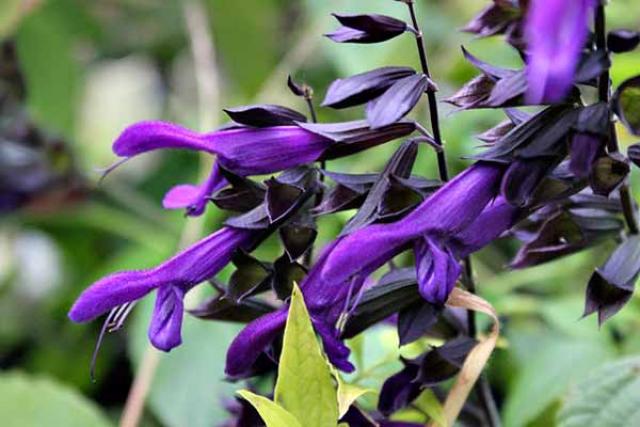Star Gardener: Mondo Plant Sale

Gardening worldwide is undergoing a sea change as ecological considerations become more influential in our garden-making decisions. The monarch butterfly is a public relations triumph, making everyone aware that pollinators — bees, butterflies, beneficial insects, and birds — ought to be nurtured in our home landscapes. At the same time, the floodgates have opened on exciting new plant introductions, a goodly number of which will be offered tomorrow and Saturday morning at the Garden Club of East Hampton’s annual garden party and plant sale at Mulford Farm. Above all, we’ve selected perennials that are ornamental, many with flowers in bright, saturated colors. After that, the focus is on perennials that are native plants, attractive to pollinators (about 85 percent of the selections), and deer-resistant, although that can vary day to day and site to site. About a quarter of the plants cover all bases. Salvia Amistad will probably not be hardy for us, but has caused a sensation in England and Europe and is finally becoming available here. The flowers, beloved by hummingbirds, are a rich purple, emerging from black bracts and stems. Deer-resistant, Amistad forms a shrubby, long-flowering clump. It will be in the tender plant section in the tent. Another sensation from England and Europe is, ironically, a U.S. native cardinal flower that was discovered in a group of seedlings by a plantsman in West Virginia. The hardy perennial Lobelia cardinalis Black Truffle has black foliage that turns deep maroon as the season progresses and saturated cardinal red flowers that bloom from midsummer into autumn. Both Amistad and Black Truffle would look ravishing with another native plant that I first saw in English gardens, Helenium autumnale Moerheim Beauty. Its flowers are a coppery red hat change hues over a long season. I trialed it in my own garden last year to see if it is as rugged as it was in England and if the color is as vibrant here as it was there. The answer to both is yes. Our perennials supplier grew it especially for the garden club plant sale, and I’m planning to add a mass of it to the Mimi Meehan Native Plant Garden behind Clinton Academy on Main Street. The sunny yellow native hybrid Coreopsis Full Moon would round out the vignette. This is the billowy plant at the front of the sunny area in the native plant garden that flowers from midsummer until frost. The South American Verbena bonariensis is one of the workhorses of contemporary gardens. Its sprays of small purple flowers on three-to-four-foot wiry stems are ubiquitous from June through the end of the garden year. A tender plant that readily self-seeds, a new compact selection, Lollipop, was recently introduced. It grows to only 24 inches high and would be terrific in containers as well as near the front of the border among other lower-growing plants and grasses. Last autumn I was stopped in my tracks on a visit to Glover Perennials on the North Fork by a verbena that has the same flowers as V. bonariensis, but there are many more of them occurring in candelabra-like clusters. Verbena hastata is native to the Northeast, grows two to four feet tall in sun, flowers from July into September, and attracts butterflies. A clump-former, this is a plant we ought to try. If you have a pond or water feature so much the better, as its natural habitat is moist and wet meadows. Another East Coast native plant that was new to me on that visit is Rhexia virginica, meadow beauty. It has clusters of bright rose-pink flowers with showy yellow stamens. It blooms from July through September and attracts butterflies. It is definitely worth giving it a try. Oriental poppies return to the plant sale for the first time in years. Who knew they were deer-resistant and attract hummingbirds? The varieties, however, are new. Little Patty’s Plum has satiny plum-wine flowers, Harlem has large burgundy flowers with a black base, and Royal Wedding, large white flowers with a black base. Interplant them among later-blooming perennials or salvias like Amistad that fill the space after the poppies go dormant. We’ve ordered a few perennials that are just plain gorgeous. Sedums are good pollinating plants, and African Sunset sounds too good not to grow. It has glossy, dark purple foliage and dark red flowers. Crocosmia and schizostylis are two late-flowering, spectacular South African perennials that we drool over in European gardens, but most are not hardy in our area. Crocosmia Distant Planet, with bright orange flowers on spikes to about 30 inches, is said to be hardy if planted in well-drained soil; a slope would be best, to keep the crown dry during the winter and periods of wet, but I will try it with Soil Perfector. Schizostylis Oregon Sunset has coral-red flowers and can flower into November. November, did you catch that? Jim Glover reports that it has performed well in his garden on the North Fork. Late summer gardens tend toward an overabundance of yellow flowers. What could be better than to break it up with dabs of Distant Planet and Oregon Sunset? After this perfectly dreadful winter we probably all have an urge to splurge on new plants. If you want to feel virtuous, select from the native perennials and broad variety of pollinator plants. If, on the other hand, you’d like showgirl flamboyance, we’ve got something for you, too.
